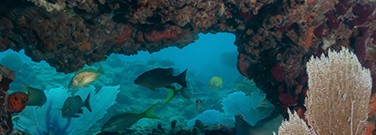Antibiotics Might Help Scientists Treat Coral Disease

By Kylie Wolfe
Stricken with a tissue-eating disease, coral reefs off the coast of Florida are dying. Now, to help them recover, experts are searching for solutions. And they just might have found their answer in a common antibiotic.
During a recent study, researchers found that amoxicillin, often prescribed for ear and chest infections, stops the disease temporarily. Their findings were published in Scientific Reports.
Trouble at Sea
Threats like warming waters, pollution, and overfishing are already stressing coral populations. Although they make up less than two percent of the ocean’s floor, coral reefs are key to underwater ecosystems. Dozens of coral diseases plague them, but little is known about each illness.
Stony coral tissue loss disease (SCTLD), nicknamed skittle-D, was first discovered in 2014 near Miami and has since traveled to the Caribbean. What begins as a white lesion quickly spreads to surrounding tissue. The spots grow until the entire organism is overtaken and, unable to fight the infection, the coral dies days or weeks later.
Today, most of the Great Florida Reef is infected. That’s 360 miles of coral. With an unknown cause and no cure, scientists began testing various treatments.
Research and Recovery
Erin Schilling, a coral researcher at Florida Atlantic University, and her team started their study in April 2019. For 11 months, they monitored 95 lesions on coral colonies of Colpophyllia natans, Dichocoenia stokesii, Meandrina meandrites, Montastraea cavernosa and Pseudodiploria strigosa.
On some, they applied a chlorinated epoxy and on others, an amoxicillin paste. To keep healthy and diseased coral tissue apart, they carved channels around the lesions and filled them with the appropriate treatment.
Of the lesions treated with epoxy, only 20 percent healed. Of those treated with amoxicillin, 95 percent healed. This occurred within three months of observation.
Questions Left Unanswered
Because of the treatment’s success, researchers speculate that SCTLD is a bacterial disease. If it’s actually viral, the tooth-paste-like cream is merely addressing symptoms and not the root cause. To combat the disease long-term would require a different treatment.
With results in hand, scientists now want to understand whether or not the coral will experience side effects, which species will respond positively, and how long the treatment will help.
Though the antibiotic doesn’t stop new lesions from appearing, it helps heal existing ones. As scientists monitor the spread of SCTLD, there’s hope that more answers lie ahead.
Discussion Questions
- Why might an antibiotic traditionally given to humans also be a viable treatment for coral disease?
- What other environmental concerns are affecting coral populations?
Vocabulary
- Antibiotic
- Coral
- Infection
- Lesion

